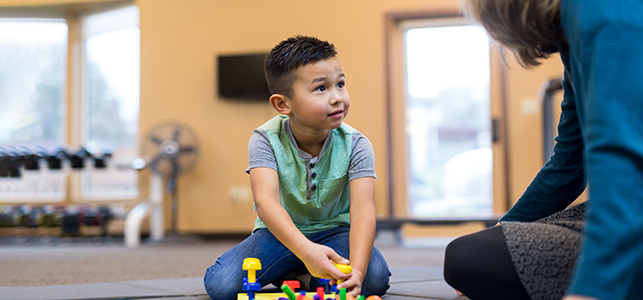
Whether a child is recovering from an injury, overcoming limitations related to an illness or needing some support reaching their developmental milestones, our occupational therapists are here to help.
Occupational therapy helps people with activities of daily life. For kids, this means learning or relearning skills needed at home and in school – like buttoning a shirt, using utensils to eat, communicating or following a series of instructions to complete a task. Pediatric occupational therapists have special education and training to consider cognitive abilities, social development, and fine and gross motor skills in the evaluation of kids’ needs and the development of treatment plans to help them meet their goals.
Of course, when working with kids the name of the game is doing the work while also having FUN! Our therapists like to call it “play with a purpose.” So, who are these skilled clinicians disguised as fun makers?
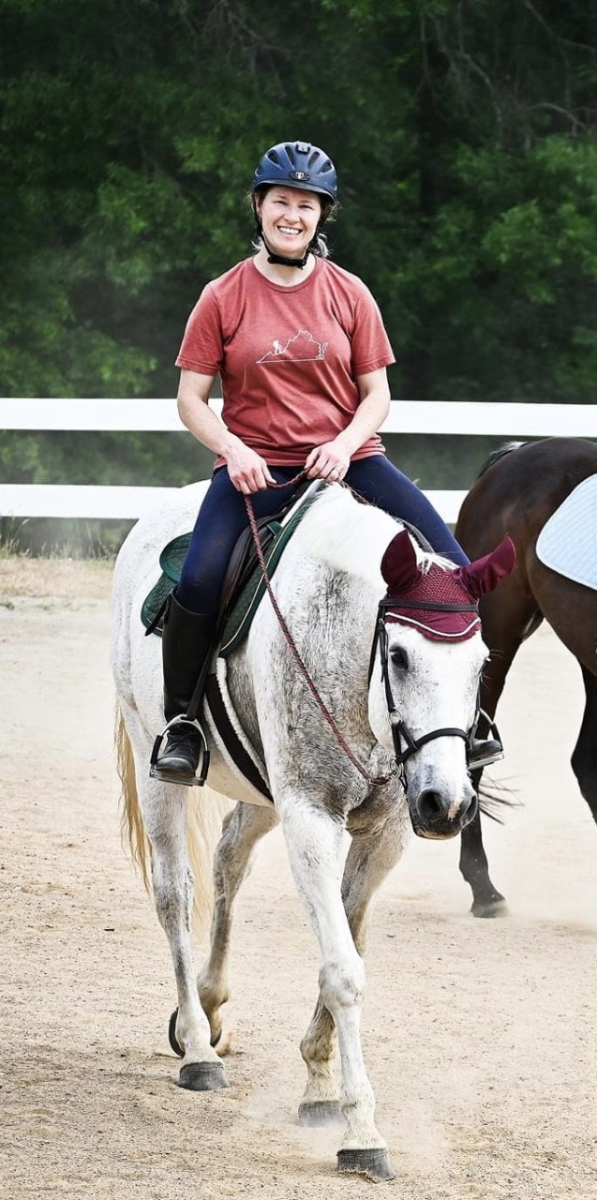 Maggie Hendricks, OTD, OTR/L | Stafford Therapy Center
Maggie Hendricks, OTD, OTR/L | Stafford Therapy Center
1. How long have you been an occupational therapist?
Almost 4 years
2. Why did you want to become an OT for kids?
A part of my mind never "grew up" so I've always felt that I am specially equipped to be a moderator between grownups and kids. As a pediatric OT, you need to be able to provide therapeutic services to not only the kids, but also to their parents and their family as a whole. I thrive off facilitating therapeutic play and helping kids discover what motivates them to engage in the occupations of childhood and to remove or reduce any barriers in their path to that engagement.
3. What does your average day look like?
What's an average day?! Aside from arriving at the therapy center at 7:30 and leaving at 4:00 there is blessedly nothing else average about my days. That may be another reason why I chose to become an OT for kids. "Kids" includes anyone from 2 months to 22-years-old and therapy ranges from banging two toys together at midline to getting back to shooting free throws with a pain-free wrist, from figuring out how to optimize arousal level in preparation for sitting at a table in kindergarten to taking notes off the board without getting dizzy following a TBI from a bike wreck, and the list goes on!
4. What’s your favorite activity to do with your patients? What does this help with?
My favorite activities usually revolve around multi-step crafts or science experiments. Oftentimes I'm working with kids who are going to make a truly glorious mess as they try to figure out how to accomplish their goals, so consequently (and understandably) their parents, caregivers and educators shy away from providing them with the opportunity. I love figuring out how to facilitate artistic creation/expression and scientific experimentation for my kids where there's no fear of how much of a mess results. Depending on the kid, this works on a variety of sensory modulation, self-regulation, fine motor and process skills, which is another reason why I enjoy it so much.
5. What was your favorite toy/activity as a child?
I cherished my extensive collections of stuffed animals, My Little Ponies and Breyer model horses, but I have to give a special mention to my stuffed horse Barony and my Breyer Apple who are extensively well travelled and bear all the marks of intense kid love. In fact, they are still in a place of honor in my home today!
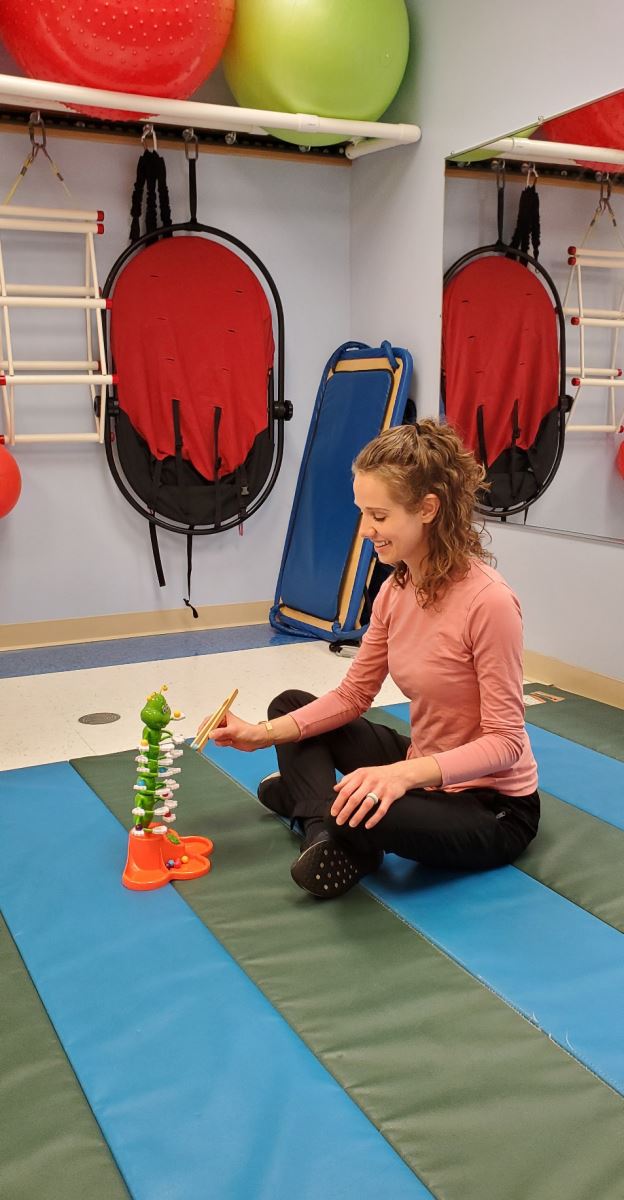 Courtney Lynch, PP-OTD, OTR/L | Petersburg Therapy Center
Courtney Lynch, PP-OTD, OTR/L | Petersburg Therapy Center
1. How long have you been an occupational therapist?
9 years – all of them at CHoR!
2. Why did you want to become an OT for kids?
Because it’s so much fun! I love working and playing with children every day. As a kid, I remember wanting to grow up as fast as possible, but this career has given me the opportunity to play again. It’s such a joy to experience the world with children as they’re learning new skills and finding happiness in small but meaningful moments.
3. What does your average day look like?
I spend most of my workday seeing patients and collaborating with caregivers and my wonderful colleagues. Right now, I have an occupational therapy student, but these are typically temporary, three-month placements. After work, I enjoy spending time with my 8-month old-daughter, sneaking in a quick play session before it’s time for dinner, bath and bed.
4. What’s your favorite activity to do with your patients? What does this help with?
This is a hard question! Probably using kitchen, wooden tongs to pick up small objects. It’s fun to use an everyday, household item, and tongs are so versatile that they can be used to play games with small pieces, clean up small toys and eat a snack. Using tongs helps to develop hand strength and separation of the two sides of the hand in preparation for grasping writing utensils and other precise, fine motor tasks.
5. What was your favorite toy/activity as a child?
I loved to dance! I started dancing when I was 5 years old and danced competitively in ballet, tap, jazz, lyrical and Irish dancing until I graduated from high school.
.jpg) Samantha Parker, M.S., OTR/L | Fredericksburg Therapy Center
Samantha Parker, M.S., OTR/L | Fredericksburg Therapy Center
1. How long have you been an occupational therapist?
7 years
2. Why did you want to become an OT for kids?
I have always really enjoyed working with kids. I’m the oldest of four children, so I’ve pretty much always been around kids and from an early age was helping to care for children. In college I ran after school play and reading groups. Then I had the opportunity to see pediatric OT services in action when I worked as an assistant to a school-based OT and later as a rehab tech for CHoR. This is when I really connected to the idea of being able to use the act of play therapeutically to help children grow and learn. Plus, kids are hilarious! I love their unfiltered, honest and heartfelt take on the world.
3. What does your average day look like?
I typically see about nine children, from toddlers to teenagers, a day for occupational therapy services. Over the course of my day I may target fine motor skills, visual motor skills, sensory processing and integration, executive functioning and activities of daily living to help children better be able to engage in play and leisure, self-care and education-related tasks across home and community environments.
We may be working on anything from improving a child’s ability to successfully handle and manipulate daily objects, to more independently using the toilet, to improving their ability to adaptively respond to sensory information in order to more confidently navigate the playground, or modifying daily activities to accommodate for difficulties in range of motion or strength so they can still do things like get themselves dressed as independently as possible.
At the end of a long, but fun day, I enjoy getting some quality time in with my husband and four dogs.
4. What’s your favorite activity to do with your patients? What does this help with?
It’s hard to pick just one, but now that we’re heading into the warmer months it’s nice to get the kids outside as much as possible. Mother Nature affords so many great therapeutic opportunities and sometimes the best activities are ones that can be done with everyday materials that you likely already have lying around the house. Spray bottles can be super fun! Fill an old one with water (smaller in size to better fit little hands if possible) and use it to practice forming shapes, draw pictures or write letters and words on outdoor surfaces like sidewalks, brick walls or fences. You can even use chalk to give kids a target to spray or lines to trace. This promotes fine motor and visual motor integration, builds hand strength, and the squeeze/release grasp pattern that is required is a good pre-cursor for using scissors. Plus getting outside offers a wide array of sensory experiences, as well as some natural opportunities to challenge balance, motor planning and coordination as they navigate a variety of surfaces and obstacles.
5. What was your favorite toy/activity as a child?
Oooh, again it is so hard to pick just one! A few of my favorites were Easy Bake Oven, Lite Brite, and a weaving loom that I used to make everyone rainbow colored potholders. Coincidentally these are all activities I still often use in my role as an OT!
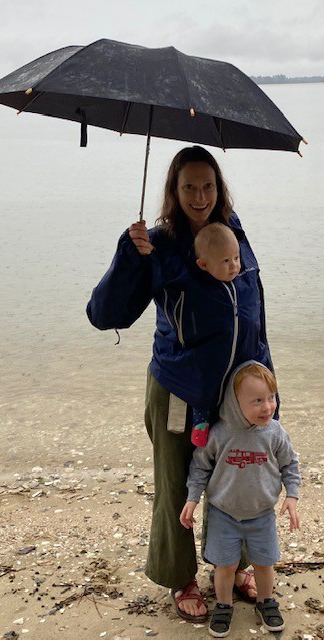 Mary Williamson, MSOT, OTR/L | Bon Air Therapy Center
Mary Williamson, MSOT, OTR/L | Bon Air Therapy Center
1. How long have you been an occupational therapist?
8 years
2. Why did you want to become an OT for kids?
I wanted to help kids feel good about themselves, and I wanted to play every day!
3. What does your average day look like?
An average day is very busy, but with a lot of playfulness and problem-solving. We see babies through age 21, and every child has their unique goals they’re working on in therapy. In one day, I might be working with a baby to gain function after an arm injury, a preschooler working on play skills and sensory regulation, and a teenager recovering from a concussion. The best part is not just the day-to-day, but the improvements we see over the course of the weeks or months, and the relationships we develop with our kids and families.
4. What’s your favorite activity to do with your patients? What does this help with?
Lately I’ve been using plastic eggs in many of my OT sessions. They’re great for working on bimanual skills (using both hands together) when opening and closing, as well as grading the amount of force required. I also work on utensil use with eggs, such as carrying them with a spoon through an obstacle course or picking them up with tongs. They are also great with tactile sensory play such as in a sand box or a bin of dry rice. And an egg hunt is a fun way to work on visual motor skills, both looking for them in a busy environment, and hiding words or letters inside for kids to copy.
5. What was your favorite toy/activity as a child?
I loved being outside and making “recipes” in my mud kitchen. I had a great time collecting flowers and acorns and getting dirty!
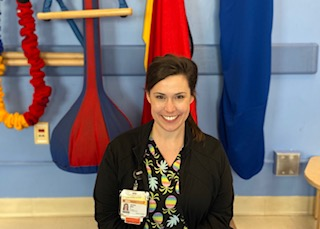 Jessica Wise, MS, OTR/L | Brook Road Campus
Jessica Wise, MS, OTR/L | Brook Road Campus
1. How long have you been an occupational therapist?
7 years
2. Why did you want to become an OT for kids?
I was an extremely independent kid – sometimes to fault! I grew up watching my mom, a special education teacher at the time, work with children whose independence didn’t come as easily. When I learned there was a career dedicated to helping kids live life to the fullest, I was sold!
3. What does your average day look like?
At Brook Road, I work with outpatients ages 0 to 21 on everything from activities of daily living and handwriting to sensory processing and more. I also get to spend time with some of our Transitional Care Unit residents providing medically based or school-based therapy. There are usually meetings or special projects to work on in between patients, so there is always something to do. I tell everyone I have the best job because I literally get to play all day!
4. What’s your favorite activity to do with your patients? What does this help with?
I love to do seasonal crafts. You can work on anything – fine motor skills, visual motor coordination, handwriting, scissor skills, visual perceptual skills, executive functioning skills like sequencing and task organization, bilateral coordination – the list goes on and on. Crafts can be adapted for any ability level, and there is nothing better than seeing a child so proud of their work when it’s done!
5. What was your favorite toy/activity as a child?
I was all about Barbies and baby dolls!